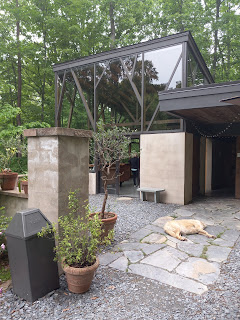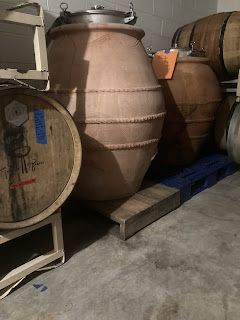Gabriele Rausse Winery
May 15, 2023. We began the second day of our Charlottesville wine trip by visiting the Gabrielle Rausse Winery, on the Southeast side of Carters Mountain. The winding Carters Mountain Road passes several wineries including the Trump Winery which announces itself unmistakably. In contrast, you must be careful not to overshoot the entrance for Gabriele Rausse. There is no sign on the road telling you where to turn. Just know the number, 3247, and look for the large black partially overgrown mailbox with white “3247” on the sides. Turn in there.
Maybe a hundred feet up the gravel driveway across Quarry Creek brings you to the small parking lot for the winery on the left. The winery building itself reminded me of how glass might be used in the later Usonian homes – to convey a sense of lightness and integration of the building into the forest. The walls that define the working space are low and accessible.

The dimensions are comfortable and inviting. With all customer seating outside on the
patio and down the hill in forest gazebos and tasting areas, the winery
building is less of a focus in the rustic setting. You may feel miles away after walking only a
few feet along the foot paths. The patio
seating almost begs you to say hello to other visitors. Keep in mind that all seating is outdoors –
so inclement weather or Summer’s heat may factor into your plans to visit on a
particular day. The forest does offer ample
shade, but this is Virginia, folks…Nuff Sed.
Gabriele Rausse has been called ‘the father of the Virginia wine industry.” We will explore his life much more in a later post. He established his eponymous winery in 1997, and this boutique operation now produces around 2,500 cases of wine a year. According to son, Tim, distribution is mostly in the Charlottesville area. The winery itself has nine acres under vine at two locations. The wines that on our tasting used grapes from five or six vineyards throughout the Commonwealth.
In addition to wines bearing the “Gabriele Rausse” label, the Rausse sons, Tim and Peter, are carrying on into the next generation with wines under the “Vino dal Bosco” label. Vino dal Bosco is their project to forego added sulfites and to age wines in Italian terracotta amphorae.
Amphorae at Gabriele Rausse Winery
(Sulfites, or sulfur dioxide, are naturally produced by yeasts during fermentation. Most wine makers worldwide add sulfites to protect against oxidation and spoilage.) For sparklers, Tim explains the process for bottle-conditioned sparkling wines using the “Methode Ancestrale”:
“Rather than fermenting a base wine dry, then adding sugar and yeast to do a second fermentation in bottle (methode champenoise), our sparklers are bottled towards the end of their initial alcoholic fermentation. Another way to think about it, we harvest the grapes mid August and bottle the wine later that month.”
I believe what Tim is describing is a natural carbonation sometimes referred to as “pétillant naturel” or “pet-nat.” About 500 of the winery’s 2,500 case production is in Vino del Bosco. Through a daughter-in-law’s connections, the winery also sells a sweet wine from Château Kalian near Bergerac (Bordeaux) France. It’s great to see the next generation moving ahead and experimenting in the industry.
When it comes to the wines, Kim had a glass of white, while I did a red tasting. Tastings are served in small sample bottles that you pour into a decent wine glass (see note under Jefferson Vineyards).
2021 Roussanne. Kim rated this an A and bought a bottle. This is 100% Roussanne from Redlands Vineyards in Albermarle County. The wine was aged in a combination of French oak, stainless steel, and Italian terracotta amphora. No malolactic fermentation.
2022 Vino dal Bosco Cabernet Franc. This is 100% Cabernet Franc from Baer Ridge Vineyards (Harrisonburg). In keeping with the Vino dal Bosco precepts, the Cab Franc contains no added sulfites, is fermented in stainless but aged mostly in amphorae. I found it very floral on the nose, good medium body and light fruit. The winery’s tasting notes advise that there may be some remaining carbon dioxide resulting in pet-nat. I didn’t sense that in my tasting, but it may have translated to a lightness in body. Very good. I rated it A and bought a bottle. These and other Vino dal Bosco labels may feature the work of artists like Allie Kelly; her woodblock adorns the Cabernet Franc label.
2022 Rosso. This is a basic table wine blending 55% Cabernet Sauvignon, 27% Merlot and 18% Cabernet Franc from four different Virginia vineyards. It is light in body. Good fruit and some tannins. 12.5% ABV. I rate it a B.
2021 Merlot. The Merlot is 85% Merlot aged totally in French oak. The fruit is more subdued. More tannin. 13% ABV. I rate it a B.
2021 Malbec. The Malbec is 100% Malbec from a vineyard in Loudoun County. Its aged 10 months on French oak. The fruit is dialed-back compared to the Merlot, and the tannins are dialed-up, as is the ABV at 13.7%. It is a great expression of the varietal. I rated it an A and bought a bottle.
2021 Tannat. The fruit is from Albermarle County. The on-site tasting notes say this offering is 100% Tannat, while the on-line notes say 90%. Its a negligible difference. I definitely got chocolate on the nose on this wine. The fruit and cola on the palate gets swabbed in a tannin finish. B.
2020 Cabernet Sauvignon. The Cabernet Sauvignon is not on the normal red tasting menu. It is 100% Cabernet Sauvignon from single vineyard in Warren County. Aged in French oak. Strong tannin and light fruit. Some alcohol burn at 14.2% ABV. Could be better balanced. I rate it a B.
Our experience at Gabriele Rausse Winery turned out to be one of our most memorable - in a good way. Give them a visit when you can.



.jpg)
Comments
Post a Comment